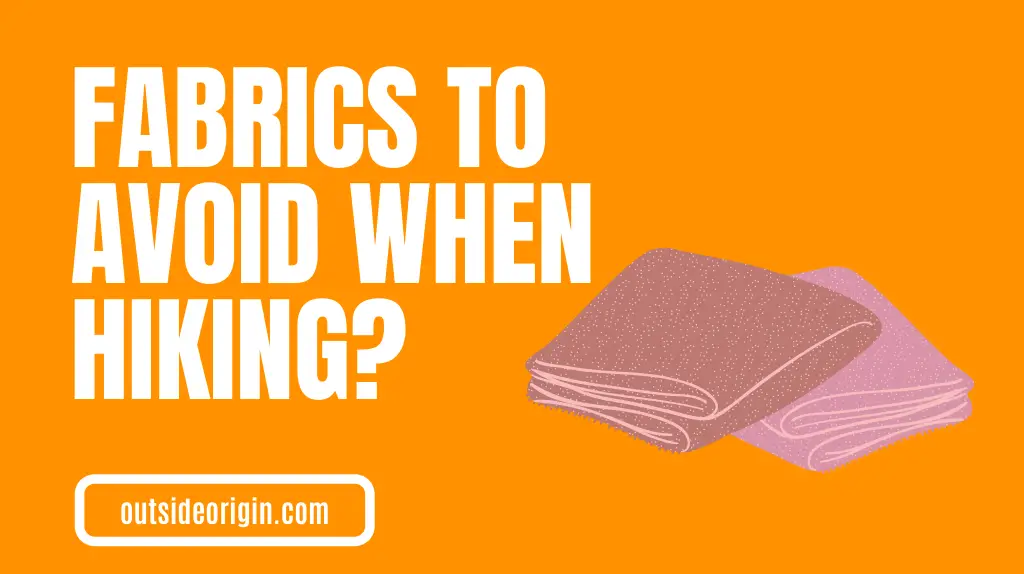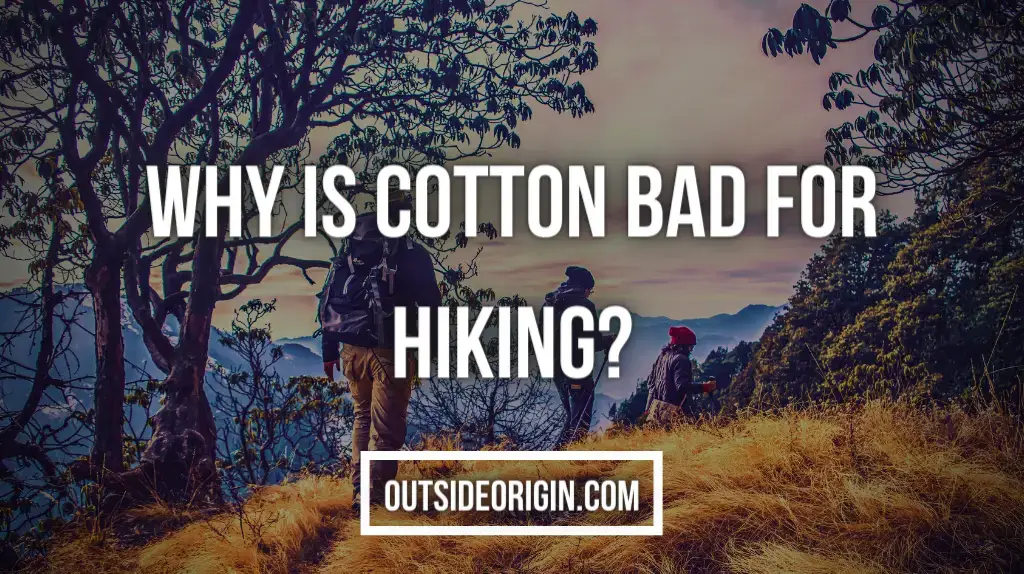In apparel, cotton is one of the most popular textiles due to its softness and breathability as well as its durability. Although, there are several limitations to cotton clothes when it comes to outdoor sports like trekking, mountaineering, and so on. Hiking clothing should be odour-resistant, quick-drying, moisture-wicking, and temperature-regulating.
Additionally, it is critical to pick clothing that dries rapidly to maintain your natural body temperature while hiking. Cotton absorbs a lot of moisture, making it heavier when wet, and it gets considerably heavier when it’s soaked with sweat.
There are several reasons why cotton isn’t a good choice for hiking apparel. Also, Cotton is one of the least sustainable fabrics on the market since it requires a lot of water for the cotton plant to grow.
Top 4 Reasons Why Cotton Is Bad For Hiking
Below are 4 reasons why cotton is bad for hiking:
1. Cotton Is Too Heavy
Cotton absorbs a lot of moisture, making it heavier when wet, and it gets considerably heavier when it’s soaked with sweat.
2. Lengthy Drying Time
Cotton is typically slow to dry due to its high absorption capacity. If you’re planning to go hiking, you’ll need clothes that dry quickly and keep your body temperature stable.
3. Too Moisture-absorbant
Cotton can absorb up to 2700% of its weight in moisture, making it an excellent material for wicking moisture away from the skin. A lot less moisture is absorbed by competing fabrics for hiking clothes. Polyester, for example, can only hold 0.4% of its weight in moisture, whereas silk can hold 30% and Merino wool can hold 33%. If you sweat a lot, you’ll notice that your cotton clothing gets heavier and loses its ability to retain heat.
4. Poor Temperature Control
You can stay warm and cool at the same time if your clothing has excellent temperature regulation. Water has a higher thermal conductivity than air, so you need to keep your skin and clothing as dry as possible even when you’re sweating. In a process called conduction, heat from your body is quickly transferred to your clothing, causing you to lose heat quickly. When trekking in chilly weather, cotton clothing can be especially problematic because it quickly loses heat from the body due to being wet in sweat. Severe circumstances may lead to hypothermia.
What Fabrics Should You Avoid When Hiking?

Whether we’re amateurs or experts, the hiking gear we choose on our hikes can make or break the entire experience. For those who haven’t hiked much in the past, it can be difficult to assess what kind of clothing is appropriate for such an activity.
Hikers make several clothing decisions that can be inconvenient or even dangerous. The following are some of the fabrics that you should avoid while hiking:
1. Cotton
You’ll soak up sweat and rain with cotton, but it won’t dry as quickly because cotton is an absorbent fibre. Cotton will make you sweat all day in the hot heat, and it will make you chilly all day in cold weather. Cotton isn’t just for t-shirts when it comes to uses for this material. Avoid cotton bras, socks or underwear as well.
2. Silk
Silk is usually unsuitable for long hikes. Silk is a no-no if you anticipate sweating a lot. However, without being chemically treated, it tends to hold on to any moisture that comes along.
Also, Silk is good at absorbing and retaining foul scents. Even though it has a sumptuous sensation when you wear it, it’s usually rather lightweight. Although thin fabrics are advantageous for airflow, they will readily shred if snagged on a rock or limb.
3. Bulky Clothes
Excessively heavy or loose clothing can be problematic on a hike. When it’s warm outside, you should choose free-flowing or loose clothes, which works well. Nonetheless, we should avoid excessively baggy pants and hefty jackets.
The same goes with the pants. If your pants are too large, they will either continue to slide down or cause inconvenient rubbing over time. In general, you want apparel that fits correctly. Avoid clothing that is very heavy or that moves around excessively.
4. Slippery Shoes
If you’re going hiking, you’re going to need footwear that can keep up with you while you walk through the woods or down a track in the wilderness. It’s not unusual for hiking trails to include boulders, river crossings, or sharp plants like cacti. In such conditions, you’ll want footwear that will keep you dry and protected from the elements the entire walk.
Footwear with a lot of treads is also a must. Many hiking trails feature inclines and declines, while some trails are completely flat. A shoe with a good grip on the ground will keep you from sliding around in these scenarios.
Why Are Cotton Socks Bad For Hiking?

No matter how short your hike, you still want to be as comfortable as possible. When your feet are in discomfort, your entire hiking experience is also in discomfort.
Cotton socks ruin a hike because of the following reasons:
- Wet cotton is considerably heavier than dry, making it a difficult fabric to wear.
- Wearing cotton will keep your feet damp since it drains away sweat and remains wet.
- Since cotton takes so long to dry, you’ll be wet for prolonged periods.
- When cotton becomes wet, it loses its ability to keep you warm by acting as an insulator.
Blisters are the most probable outcome of wearing wet, heavy cotton socks. Not to mention, blisters on the feet are your worst nightmare if you’ll ever go hiking.
What Material Is Good For Hiking?

While on a hike, the finest fabrics for trekking are wool, polyester, and nylon, as they quickly wick away perspiration and dry. Itchy, irritated, and blistering skin in the armpits can be a sign of dermatitis, and these moisture-wicking fabrics can help keep that from happening.
Wearing shorts and sleeveless tops may be enticing, but they are not ideal for trekking. If you’re going to be spending a lot of time outside, be sure you’re prepared for the sun’s harmful rays. Your skin will become dry, burned, and spotty, making it more sensitive to the sun’s rays.
Long-sleeved apparel provides an additional layer of protection from the sun’s harmful rays. Additionally, wide-brimmed headgear is essential. During the summer, you won’t need as many layers, but it’s still a good idea to have a waterproof and insulating jacket on hand just in case.
Conclusion: Final Thoughts!
To sum it up, wool or polyester clothing is preferable to cotton clothing. Extra protection can be obtained by donning socks with liners. To be on the safe side, consider using anti-blister hiking socks.
It is a good idea to wear socks with your hiking boots or shoes depending on the sort of footwear you have, the weather, and your skin type. The height of your sock should be determined by the type of footwear you wear. Ankle support is critical if you plan on trekking a lot in areas with steep slopes.
Can You Do Me A Small Favor?
I have put a lot of time & effort into writing this post to provide you with the best info out there.
It’ll help me out if you could consider sharing it on your social media networks. You are also allowed to take any photo you want from my blog as long as you credit and link back!
Appreciate it! ❤️️

Hey, I am the founder of Outside Origin! I love hiking in my spare time and have gone to various different hikes. You can check out our about us section to learn more about what our team and I do over at Outside Origin.




